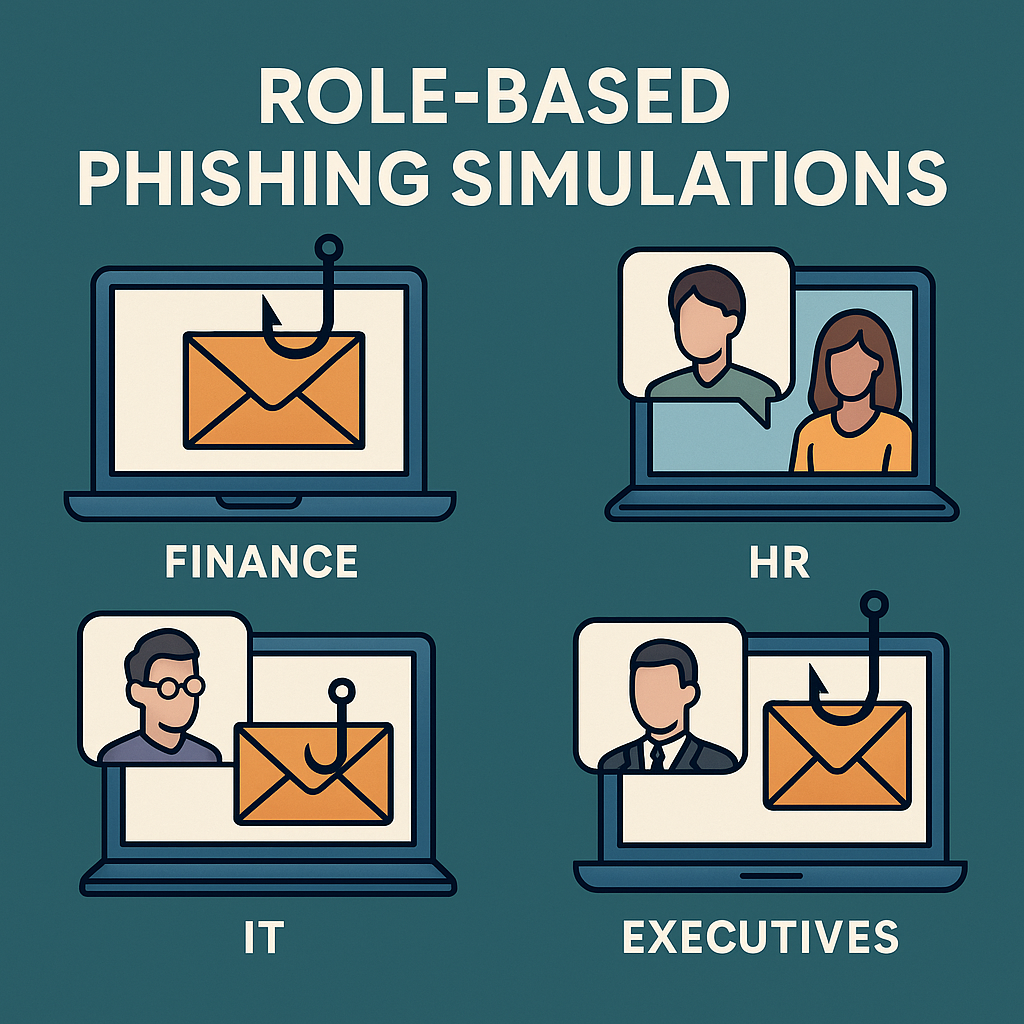Role-Based Phishing Simulations: Finance, HR, IT & Execs — Scenarios, Guardrails, and Metrics

Why Role-Based Training Matters
Phishing is still the number one entry point for cyberattacks. According to Verizon’s 2024 Data Breach Investigations Report, over 68% of breaches involve the human element, with phishing and stolen credentials leading the charge.
The problem? Not all employees face the same risks. A finance controller has very different exposure compared to an HR manager or an IT helpdesk agent. This is why role-based phishing simulations are now considered best practice for any serious security awareness program.
Instead of sending the same generic “password reset” email to everyone, role-based simulations:
- Target specific job functions with realistic but safe scenarios.
- Train employees on the threats they’re most likely to face.
- Provide actionable metrics to improve defenses where they matter most.
This blog post will walk you through scenarios, guardrails, and KPIs for the four most at-risk groups: Finance, HR, IT, and Executives.
Finance: Wire Transfers and Invoice Fraud
If you’re in finance, you’re on the front line of Business Email Compromise (BEC) attacks. Criminals impersonate suppliers, executives, or even regulators to trick employees into approving fraudulent payments. Losses from BEC scams exceeded 55 billion over the last 10 years.
Example Scenarios
- Invoice Fraud: Fake invoice request from a “supplier.”
- CEO Wire Request: Spoofed executive email asking for urgent payment.
- Bank Verification: Request to “confirm account details” via a link.
Guardrails for Simulations
- Don’t use personal/emotional triggers (“bonus payment” or “layoff list”).
- Keep simulations clearly professional and finance-related.
Metrics to Track
- % of users who click the link.
- % who attempt to initiate payment.
- % who report the email via the phishing button.
HR: Payroll & Sensitive Data
HR departments are gold mines for attackers: payroll data, PII, and access to employee portals. Attackers often pose as staff requesting urgent changes.
Example Scenarios
- Payroll Diversion: Request to change direct deposit details.
- Resume Malware: “Candidate” attaches a poisoned CV.
- Policy Update: Fake HR portal login for compliance documents.
Guardrails for Simulations
- Never simulate life events like pregnancies, medical issues, or layoffs.
- Avoid emotional manipulation — focus on administrative risks.
Metrics to Track
- % who download attachments.
- % who enter credentials.
- % who report the email via the phishing button.
IT: MFA Fatigue & Account Resets
IT staff are bombarded with requests — a perfect target for attackers abusing MFA fatigue or password reset flows.
Example Scenarios
- MFA Push Flood: Repeated login requests from “new device.”
- System Update: Spoofed IT alert with a login link.
- Ticket Escalation: Fake service desk message with embedded URL.
Guardrails for Simulations
- Make it clear this is not a test of job performance.
- Avoid highly technical jargon that could confuse non-IT staff if simulations spill over.
Metrics to Track
- % of MFA prompts accepted without verification.
- % who click malicious IT links.
Executives: High-Value Targets
Executives are prime targets for whaling (CEO fraud) and contract scams. Attackers know they’re busy, trust assistants, and often bypass standard processes.
Example Scenarios
- Contract Signature: Urgent DocuSign link for a new deal.
- M&A Leak: Confidential acquisition “details” requiring login.
- Board Communication: Fake message from a board member.
Guardrails for Simulations
- Don’t embarrass executives with trivial lures.
- Keep tone professional; focus on decision-making risks.
Metrics to Track
- % of executives who click without verification.
- Response time to report suspicious emails.
- Cross-check with assistants/EA reporting behavior.
Cross-Department Simulation Guardrails
While each department has its nuances, there are common rules that keep simulations safe and constructive:
- No “gotcha” emails. Training should build trust, not resentment.
- Stay professional. Avoid personal or sensitive themes.
- Be transparent. Communicate to staff that simulations are ongoing and for their protection.
- Respect works councils and privacy. Tools like AutoPhish anonymize results and support GDPR compliance.
Building a Simulation Roadmap
Here’s how to scale role-based training:
- Phase 1: Start broad — generic phishing for all staff.
- Phase 2: Introduce role-based simulations by department. This can easily be done by using AutoPhish's campaign feature, setting up role-based campaigns.
- Phase 3: Cross-department scenarios (e.g., fake invoice sent to both Finance and Execs).
- Phase 4: Adaptive campaigns.
This phased approach avoids overwhelming staff and shows measurable improvement.
Final Thoughts
Role-based phishing simulations are no longer a “nice to have.” They’re the difference between a generic awareness program and one that actually reduces risk where it matters most.
By focusing on scenarios, guardrails, and metrics, you can train Finance, HR, IT, and Executives in the threats that target them directly — and build a culture of resilience.
Ready to see it in action? Try AutoPhish today and make your next simulation smarter, safer, and role-aware.